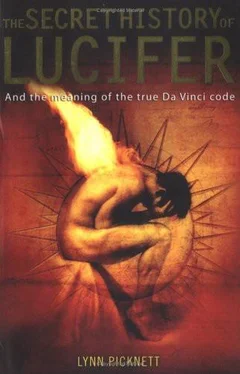One of the most intriguing of the French `Satanists' was Eugene Vintras (1807-75), who established his Church of Carmel - also known as the Oeuvre de la Misericorde (Work of Mercy), in the early 1840s. Clearly a charismatic figure, Vintras appealed to high society, but soon his movement was accused of Satanism, largely because his rites were highly sexual in nature. Worse, Vintras was embroiled in a massive political scandal centred on Charles Guillaume Naundorff (1785-1845), who claimed to be the `lost' King Louis XVII, believed by most to have died during or shortly after the French Revolution in the 1790s. Naundorff and Vintras publicly backed each other, the latter ending up in what was clearly a show trial accused of fraud. After five years in jail, Vintras fled to London, as France was rapidly becoming too hot to hold him. A former member of his Church of Carmel, one Father Gozzoli published a pamphlet accusing him of organizing the most debauched orgies imaginable - and Gozzoli seems to have possessed a particularly lurid imagination. In 1848 the sect was declared heretical by the Pope and all its members excommunicated, whereupon they established themselves as a totally independent entity, with both male and female priests, rather like the Cathars.
What is especially interesting is that both Vintras' Church of Carmel and the Naundorff supporters were a shadowy sect called `the Saviours of Louis XVII' - otherwise known as the Johannites. A complex and elusive group, they were primarily concerned with the restoration of the monarchy in France, although they supported less obvious individuals and causes. These particular Johannites appear somehow to have `stage-managed' visions of the Virgin at La Salette in 1846, probably as part of a wider campaign to elevate the Feminine, first by emphasizing the role of Mary the Mother, then through more overtly sexual means and active hostility to the Church. Vintras' own link with the Johannites was through the evocatively named `Sister Salome' (Madame Bouche), but on his death the Order passed to the keeping of the scandalous Abbe Joseph Boullan (1824-93), who had set up the Society for the Reparation of Souls in 1859 with the much younger Adele Chevalier, whom he had seduced at the convent at La Salette. Matters escalated from highly controversial to outright shocking when Boullan extended his sex rites to the animal kingdom, and rumours spread like wildfire that he and Chevalier had sacrificed their own child during a Black Mass in 1860: interestingly, neither was even arrested for such an offence, although they were convicted of fraud.
The plot thickens, however. After serving a custodial sentence, Boullan of his own volition presented himself to the Inquisition in Rome, but even they could find no fault in him. He was free to return to Paris'21 where he threw himself into leading Vintras' Church of Carmel into ever increasing scenes of wild sexual licence, first declaring himself to be the reincarnation of John the Baptist. This may have inspired his portrayal as `Dr Johannes' in Huysmans' La Bas - also one of Boullan's aliases - although it would be quite wrong to assume that he was the villain of the piece. In fact, he was a friend of Huysmans who depicted him as a crusader against Satanism, though much maligned by the Church. But to this day there are major questions to be answered about Boullan. As we wrote in The Templar Revelation:
While in Rome Boullan wrote his doctrines down in a notebook (known as the cahier rose, overtly after the colour of the cover), which was found by ... Huysmans among his papers after his death in 1893. The precise details of the contents are unknown - though it was described as a `shocking document' - and it is now locked away in the Vatican Library. All applications to see it are refused .27
Was Boullan actually a sort of agent provocateur for the Vatican, infiltrating a heretical group in order to undermine it? Certainly it is very odd that, despite all the melodramatic and salacious rumours, he was only convicted for fraud and the Inquisition could find no fault with him. But if not a Vatican agent, perhaps he knew some great secret that he could wield as blackmail even against the might of Peter's Church. Perhaps it was connected with what may well have been the real John the Baptist, and the sex rites of the original Christians, including Jesus and the Magdalene ... To most ordinary Christians, that would seem like Satanism.
Orgies in the caves
Secret and semi-secret societies mushroomed in the eighteenth and nineteenth centuries, perhaps inspired by the new wave of Romanticism, revolutionary politics or the radical thinking that would produce embryonic trades unions, but they were more likely to concentrate on drinking and leching, with a hefty pinch of pseudo-Satanism thrown in for added spice. In England, the most famous of these clubs for the terminally bored was the Order of the Friars of Wycombe, or The Monks of Medmenham, the Order of the Knights of West Wycombe, or - most famously but inaccurately - the Hellfire Club.
It was founded by Sir Francis Dashwood (1708-81), a wellestablished MP and former Treasurer to George III and Postmaster General: the epitome of the successful English gentleman. On the obligatory Grand Tour of Italy, he had come to hate the Catholic Church and, having met the legendary `Bonnie Prince Charlie' - the exiled Prince Charles Edward Stuart - he was enrolled as a Jacobite agent. He went on to become involved in various Rosicrucian, neoTemplar and Masonic Lodges. In 1738 Pope Clement XII had prohibited Freemasonry and excommunicated all the Italian brotherhood on pain of being handed over to the Inquisition, but Dashwood remained in contact with the Italian lodges. As a young traveller through France he had been an observer at a Black Mass, which intrigued him, but only at the more puerile level of insulting the Church.
Back in England he founded the Society of the Dilettanti, one of the many London clubs devoted to phenomenal alcohol consumption and whoring. In 1746 he founded the Order of the Knights of Saint Francis, which met at the sixteenth-century George and Vulture pub in the City of London, made famous in Charles Dickens' riotous first novel, Pickwick Papers (1836-7). They met in an upper room, the focus of which was `an everlasting Rosicrucian lamp', a massive crystal globe surrounded by a gold snake with its tail in its mouth, and topped by silver wings - a profoundly Gnostic design, which also appeared on the font Dashwood later presented to West Wycombe Church.
It was close to West Wycombe in Buckinghamshire that Dashwood and his cronies established their infamous `Hellfire Club', at Medmenham Abbey on the River Thames near Marlow in 1751. Dashwood lavishly renovated the former medieval monastery - no expense was spared - complete with the now infamous motto carved over the entrance `Do as thou will'. The temple to hedonism was complete with a priapic statue and a voluptuous statue of Venus in the well-tended gardens. As she was bending over, a clumsy newcomer would find himself already in a compromising position before he had even entered the house.
Two ancient deities of Silence - the Egyptian Harpocrates and the Roman goddess Angerona - adorned the Abbey's sumptuous dining room, perhaps as a reminder to the Order's members never to speak of the goings-on there in the outside world. Pagan gods were everywhere in Dashwood's life: one whole wing of his house, designed by Robert Adam, was a replica of a Temple to Bacchus, while Ariadne, Dionysus and a whole host of cavorting satyrs frolicked over the ceiling. Statues of other ancient deities graced the gardens, which some said were laid out in the rather graphic shape of a naked woman.
In 1750 Dashwood enlarged the honeycomb of tunnels and caves under West Wycombe Hill in which to hold the Order's meetings, although word spread that they took the form of orgiastic couplings. As occult writer and Dashwood expert Mike Howard explains:
Читать дальше












